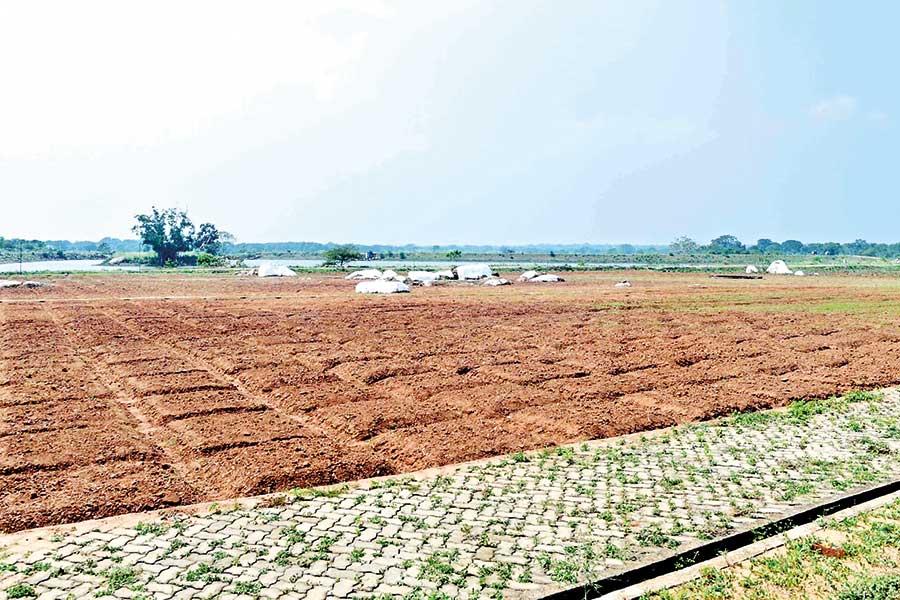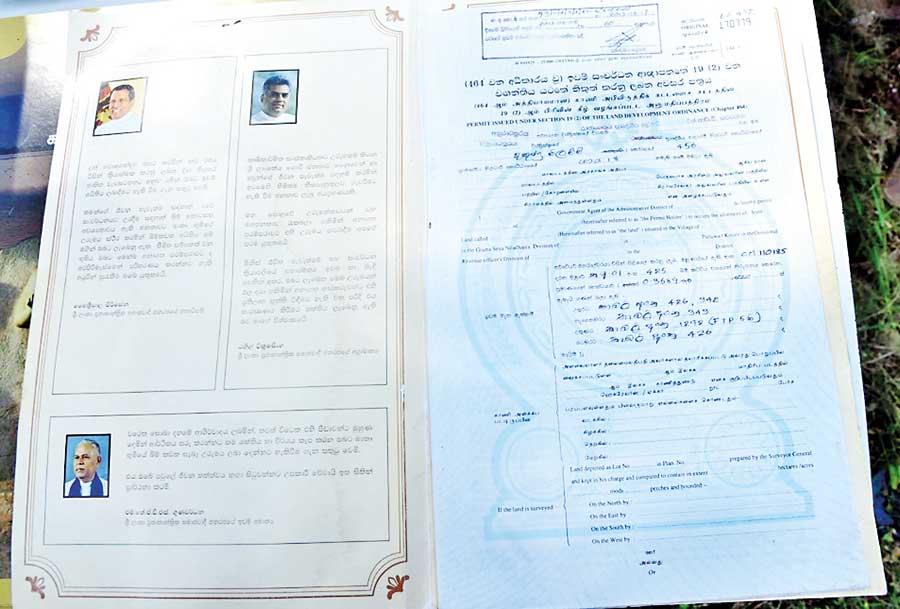Reply To:
Name - Reply Comment

A plot of land being prepared for aloe vera cultivation in the controversial 18 area colony
(pix by Samantha Perera)
- There are concerns about plans to start a large-scale aloe vera plantation in Rajanganaya Yaya ‘18 area’ which endeavour environmental organizations point out would be a threat to the buffer zone of Wilpattu
- Recent developments in planning for the project now question the ownership of the lands of original settlers in the ‘18 area’
There have been allegations for about six years that Aura Lanka Herbals (PVT) Ltd is preparing for a large-scale aloe plantation in the Rajanganaya Yaya ‘18 area’ by destroying the buffer zone of Wilpattu National Park. This accusation has been made by environmental organizations as well as the Department of Wildlife Conservation (DWC). Surakimu Sri Lanka President Pahiyangala Ananda Sagara Thera has also alleged that Viranjith Thambugala, Managing Director of Aura Lanka (PVT) Ltd, intends to acquire 125,000 acres in the Anuradhapura district under the guise of having an aloe vera plantation. Leave aside the intended cultivation of aloe vera there remains a serious concern regarding the rightful ownership of the lands in the ‘18 area’ for the local populace.
zone of Wilpattu National Park. This accusation has been made by environmental organizations as well as the Department of Wildlife Conservation (DWC). Surakimu Sri Lanka President Pahiyangala Ananda Sagara Thera has also alleged that Viranjith Thambugala, Managing Director of Aura Lanka (PVT) Ltd, intends to acquire 125,000 acres in the Anuradhapura district under the guise of having an aloe vera plantation. Leave aside the intended cultivation of aloe vera there remains a serious concern regarding the rightful ownership of the lands in the ‘18 area’ for the local populace.
Colonization scheme in Rajanganaya
The Rajanganaya ‘18 area’ colonization scheme began in the 1960s, centred around the Rajanganaya reservoir. Former Prime Minister Sirima Bandaranaike formulated the plans for it. Initially, this colonization scheme aimed to supply rice, vegetables, and fruits to the local market under the name of Rajanganaya. However, this objective has not been realised as expected. Despite this past, Aura Lanka (PVT) Ltd is currently planning to cultivate aloe vera in the ‘18 area’ colony. Reports indicate that this aloe vera plantation is in the Wilpattu buffer zone, and licences for lands- where cultivation is to take place- have been granted to beneficiaries san the approval of the DWC.
“Around 1980, the old wildlife office was located approximately 2 km from its current location, close to where the Wilpattu National Park stands. We were given lands and we cultivated in the buffer zone. The old wildlife office was situated on the opposite side of Kala Oya, in an area known as ‘Ali Wadiya’. Adjacent to this area is called the ‘Bawum Mayima’, beyond which lies the boundary of Wilpattu. ‘Bawuma’ marks the point where the Wilpattu boundary and the buffer zone diverge. “Roads were constructed to facilitate vehicular access to this area. During the rainy season, when the water level in Kala Oya rises, wildlife officers found it difficult to cross the canal. My father constructed a hut at the end of our land to provide temporary accommodation for wildlife officers. Locals commonly called this hut the ‘game hut’ because it was where captured game meat was held. After we settled in ‘18 area’ we cultivated and the land we farmed on for 40 years remains to this day. Some landowners have permits while others do not. The address is given as ‘18 area’, Kalaoya, Rajanganaya,” Lasantha Ilukwaththa, one of the original residents of ‘18 area’ village, said during a conversation with this newspaper.
After we settled in ‘18 area’ we cultivated and the land we farmed on for 40 years remains to this day. Some landowners have permits while others do not. The address is given as ‘18 area’, Kalaoya, Rajanganaya
- Lasantha Ilukwaththa, one of the original residents of ‘18 area’ village
“Wildlife officers came to our lands and erected a hut, followed by a sign prohibiting entry into the park. Now, the Department of Wildlife Conservation claims that the area belongs to the buffer zone; extending up to 1.6 km from the location of their new office. The boundaries they currently present are incorrect. By adjusting the old boundaries and conducting accurate measurements, the truth of this matter can be revealed. Around 100 families were settled at that time in ’18 area’. During the war, one family from the village was killed. Many people left the old village and resettled in the present lands, which are government-owned. About 2 kilometres towards the forest from the current DWC office, you find the ‘Bawum Mayima’. Beyond that is the Wilpattu boundary. The old wildlife office was situated near ‘Ali Wadiya’. We were allocated land in the buffer zone. Letters submitted to the Grama Niladhari officer in 1990 requesting licences by individuals, who did not have land licences, for the areas we inhabit today, still exist. My father (I. Dharmasena) is well acquainted with this story. He is now 73 years old. During that time, we learned English from Liyanage, who was an officer of the DWC,” he added.
 “Below the Kahambiliyapitiya Wewa there are paddy fields that were formerly cultivated using water from the Rajaganaya reservoir. Initially, we had an ample supply of water. However, problems arose with the canals, resulting in water scarcity, which made people choose chena cultivation. Even today, water is obtained from the Rajanganaya reservoir to supply the Wewa. Canals were dug, culverts were built, and coconut trees were planted during that time; these assets still exist today. We continue to utilise our lands within the buffer zone, cultivating turmeric and lemongrass. However, the DWC authorities have now established a new buffer zone without mentioning the original boundaries, for their convenience, claiming it as government land,” Ilukwaththa said adding that they have evidence to refute this claim.
“Below the Kahambiliyapitiya Wewa there are paddy fields that were formerly cultivated using water from the Rajaganaya reservoir. Initially, we had an ample supply of water. However, problems arose with the canals, resulting in water scarcity, which made people choose chena cultivation. Even today, water is obtained from the Rajanganaya reservoir to supply the Wewa. Canals were dug, culverts were built, and coconut trees were planted during that time; these assets still exist today. We continue to utilise our lands within the buffer zone, cultivating turmeric and lemongrass. However, the DWC authorities have now established a new buffer zone without mentioning the original boundaries, for their convenience, claiming it as government land,” Ilukwaththa said adding that they have evidence to refute this claim.
The Daily Mirror then consulted Rajanganaya Divisional Secretary Upali Rajapaksa regarding this issue. He said, “I have recently assumed duties, but the allocation of these lands and the commencement of aloe vera cultivation began around six years ago. I have discussed this issue with the Grama Niladhari officer and it has been confirmed that licences for these lands were issued legally following proper legal procedures, and after conducting Land Kachcheris. I requested the Department of Wildlife and Conservation officers to show their boundaries. However, they have stated that they cannot provide this information due to an ongoing legal issue. I am seeking clarification on whether these licences were granted within the wildlife zone and if aloe vera cultivation was permitted in the wildlife reserve. I have previously inquired with the Department of Wildlife Conservation regarding this matter, but a proper response wasn’t provided. Aloe vera cultivation is presently being carried out on licenced lands only; no cultivation is being done on lands without a licence. Farmers are engaged in aloe vera cultivation. We need to know the boundaries of the buffer zone. This issue will be solved if there is an accurate demarcation of the buffer zone boundary by the Department of Wildlife Conservation authorities. The Grama Niladhari officer has also pointed out that the buffer zone boundaries have been brought forward by the Department of Wildlife Conservation,” said Rajapaksa.
I have never acquired any land belonging to the Wilpattu National Park or its buffer zone. Aloe plants have not been planted within any wildlife reserve under my direction. My involvement was reaching agreements with farmers in the ‘18 area’ farming colony to cultivate aloe vera on their lands”
-Viranjith Thambugala, Managing Director, Aura Lanka (PVT) Ltd
The divisional secretary can issue licences for plots of land within a buffer zone. However, any development work requires the approval of DWC authorities. DWC officials claim that development work has been undertaken without their permission. “Nevertheless, permission wasn’t sought because the area designated for aloe vera cultivation in ‘18 area’ does not fall under the jurisdiction of DWC. No licences have been issued for lands below the KahambiliapitiyaWewa. However, some farmers have been cultivating that area for 40 years. Department of Wildlife Conservation authorities say that these fields are within the reserve zone. If they obtain a court order to revoke licences issued for buffer zone lands, we can revoke those licences. However, Department of Wildlife Conservation authorities must demonstrate that the licences issued pertain to lands within the reserved area. Furthermore, if the aloe vera plantation is within the buffer zone, wildlife authorities should clearly show the boundaries. This aloe vera cultivation is not an individual project; farmers have only prepared their land. The trees that were there were legally felled in 2018, as confirmed by the Grama Niladhari official. Therefore, it is on the authorities of the Department of Wildlife Conservation to demarcate boundaries and clarify whether the area is within the reserve or not. Our land officers say that the lands granted are not inside the buffer zone, but from government land situated outside. Consequently, we don’t require special permission from Department of Wildlife Conservation authorities when issuing land licences,” Rajapaksa said.

A deed for a land provided in the year 2015
No permission for cultivation
When this newspaper approached Anuradhapura Wildlife Assistant Director W.M.K.S. Chandraratne, he provided the following response: “The 18 area village falls within the wildlife buffer zone, where aloe vera cultivation is taking place. The boundary of the wildlife reserve is near the Kala Oya, with the buffer zone extending 1.6 km from this point. Any development within the reserve requires special permission from the wildlife authorities, accompanied by environmental impact assessments and other necessary approvals. Currently, an aloe vera cultivation is being undertaken without obtaining permission from the Department of Wildlife Conservation, prompting legal action under the fauna and flora Ordinance. However, if proper approval is sought beforehand, we are open to considering such projects. The Rajanganaya Divisional Secretary has issued land licences to farmers in ‘18 area’ without seeking permission from the Department of Wildlife Conservation during the distribution process despite holding Land Kachcheri. Thambugala has failed to obtain permission from the Agrarian Development Department or the Irrigation Department for the construction of Kahambiliapitiya Wewa. Farmers have been allowed to engage in paddy and chena cultivation within the reserve for a long time and these activities continue to this day. The law related to Wildlife Buffer Zone was enacted in the 1990s, stipulating that development may be permitted within the buffer zone provided it does not cause significant environmental harm. This situation arose because aloe vera cultivation was carried out without obtaining approval from us. Once this legal matter is resolved, if a formal request is submitted and there is no significant environmental impact, permission can be considered. The fauna and flora ordinance holds considerable weight in such cases. If these lands fall within the wildlife buffer zone and environmental damage occurs due to the issued licences, the Department of Wildlife Conservation authorities have the authority to revoke those licences,” he added.
This newspaper also consulted Sampath Samarajeeva, Engineer in charge of the Rajanganaya Reservoir in the Irrigation Department. Samarajeeva stated the following: “When establishing a colonization scheme, permission is sought, and government lands, wildlife lands, and forest conservation lands are released for development of canals and dams. The ‘18 area’ village was established with such permission; which is why farmers cultivated fields and chena within the reserve and its buffer zone. However, due to the stringent regulations of the Fauna and Flora Ordinance, the boundaries were later revised, and maybe it was said that these lands fall under the jurisdiction of Department of Wildlife Conservation authorities. If Department of Wildlife Conservation demands the return of lands currently cultivated by our farmers within the buffer zone, we would be obliged to vacate both cultivation and residential lands within the Wilpattu Reserve. Following the establishment of the Rajanganaya ‘18 area’ colonization scheme, there was insufficient water to support cultivation during both seasons. Consequently, farmers alternated between cultivating paddy fields and practising chena cultivation with rainwater. Some individuals relocated from these areas, resulting in certain lands being left fallow, which could potentially be designated as protected areas by wildlife authorities later. However, if wildlife authorities claim ownership of these lands and refuse to release them, the residents of the ‘18 area’ colony will be compelled to vacate the Wilpattu Reserve lands. In such circumstances, the Irrigation Department will intervene to support the farmers. This is not an issue where institutions should act separately. This issue needs collaboration among all government institutions to find solutions,” Samarajeeva added.
Anura Ramanayake, Director Anuradhapura office, Central Environment Authority, made the following statement during an inquiry: “We have not received any requests to initiate an aloe vera project. If it is a project, a report detailing the project’s scope, methodology and cost must be submitted. However, if it involves individual cultivation with farmers, our permission is not required. Permission from our authority is only necessary for formal projects. Should such a request be made, it will be duly considered. We have advised Thambugala to treat aloe vera cultivation as a project and to provide a detailed project report. Individual collaboration among farmers does not make a project,” said Ramanayake.

“I have only been granted 6 acres to set up a factory”- Thambugala
 This writer then made queries from the Aura Lanka Managing Director Viranjith Thambugala, regarding this matter. He provided the following response: “I have never acquired any land belonging to the Wilpattu National Park or its buffer zone. Aloe plants have not been planted within any wildlife reserve under my direction. My involvement was reaching agreements with farmers in the ‘18 area’ farming colony to cultivate aloe vera on their lands. I have facilitated the necessary infrastructure for aloe vera cultivation on these farmers’ lands with licences and deeds through agreements with Aura Lanka Herbal (PVT) Ltd.
This writer then made queries from the Aura Lanka Managing Director Viranjith Thambugala, regarding this matter. He provided the following response: “I have never acquired any land belonging to the Wilpattu National Park or its buffer zone. Aloe plants have not been planted within any wildlife reserve under my direction. My involvement was reaching agreements with farmers in the ‘18 area’ farming colony to cultivate aloe vera on their lands. I have facilitated the necessary infrastructure for aloe vera cultivation on these farmers’ lands with licences and deeds through agreements with Aura Lanka Herbal (PVT) Ltd.
“The plan was for Aura Lanka Herbal (PVTP Ltd to purchase harvested aloe vera plants and manufacture herbal products through a production process. This project aimed to contribute to the country’s revenue by generating dollars. There were ambitions to create thousands of direct and indirect job opportunities, from aloe cultivation to factory employment. However, all these plans were halted due to issues surrounding the Wilpattu buffer zone. Up to now, no land within a government reserve without proper licences or deeds has been cleared. Individuals, who farmed using lift irrigation and rainwater since the establishment of the ‘18 area’ colonization scheme, abandoned their lands. My involvement has been in initiating commercial cultivation on these abandoned lands. This initiative aims to uplift the local economy and strengthen the country’s economy. All it required was the participation of farmers within this area in aloe cultivation.
“Many accuse me of attempting to acquire 125,000 acres in Anuradhapura district, which is incorrect. I have only requested 66 acres for now. This is evidenced by Cabinet Memorandum No. MF/LA/07/CM/2021/162 dated 08-27-2021, issued through the Ministry of Finance. Despite my request for 66 acres, I have only been granted 6 acres to set up a factory for manufacturing aloe vera products; subject to approval under certain conditions. However, due to the current situation, work on the factory has been halted, and the allocated 6 acres remain undeveloped.
“I renovated the Kahabiliapitiya Wewa using my personal funds. As a result, farmers have been able to work their fields. The Department of Wildlife Conservation had a plant to build an anicut across the Panankadu canal and I attempted to construct it at my own expense. However, the Department of Wildlife Conservation authorities initiated legal action against me, claiming that it was in the Wilpattu buffer zone. Furthermore, legal proceedings have been initiated against me for providing a backhoe to a farmer to develop a field within the reserve. Apart from these instances, no legal action has been taken to halt aloe vera cultivation.
“If my aloe vera cultivation activities are within the Wilpattu Reserve buffer zone and if I am engaged in a wrongdoing, please let me know. If these lands, allocated to farmers by the government, are part of a wildlife reserve, a survey should be conducted to verify this claim. If I am found to be in violation of any regulations, the authorities should put a halt to this cultivation or inform us about the proper procedure. Then we can carry out these activities legally. We have obtained approval from all relevant institutions required for each of our cultivations,” said Thambugala.
R.M.P. Senaratne and E.A.S. Edirisinghe from the ‘18 area’ village, who have leased their land for the aloe vera cultivation, said that they had entered into agreements with Aura Lanka Herbal (PVT) Ltd voluntarily. These individuals, residing in ‘18 area’ village for 40-60 years, claim to have settled on lands allocated by the government. They say that they have licences and deeds given by various governments that came into power. They explain that due to insufficient income from agriculture, they opted for aloe vera cultivation under agreements with Aura Lanka, (PVTP Ltd with compensation being provided for the use of land. However, they now face a major issue regarding land ownership, as the Department of Wildlife Conservation authorities claim that their settlement falls within the Wilpattu buffer zone. Currently, around 500 families reside within ‘18 area’ village, and they urge the President and relevant authorities to validate their land ownership rights.
Thambugala is a businessman who has undertaken this project with the expectation of long-term profitability. However, given the current precarious situation, he has not given assurance that he will not abandon the aloe vera cultivation project. If the Department of Wildlife Conservation exercises its authority under the ordinance to revoke licences and reclaim these lands, the 500 families of ‘18 area’ stand to lose their livelihoods. While the Irrigation Department claims to support farmers in such circumstances, there is no guarantee of a permanent solution. Against this backdrop, ‘18 area’ farmers may be compelled to leave their homes, resulting in the disappearance of ‘18 area’ colony from the island’s map. It is the responsibility of every responsible government authority to secure the land rights of these farmers to prevent such an unfortunate outcome, ensuring the protection of Wilpattu National Park and its buffer zone.